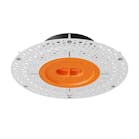CLD reduces energy consumption at Rudyard Kipling museum with LED lighting
April 21, 2014
Commissioned by the National Trust, designer Mike Blacker of East Grinstead, Sussex, UK based Blacker Design was asked to mastermind a refurbishment plan for lighting in the museum area of Bateman’s – for over 30 years from 1902, the home of author Rudyard Kipling, near Burwash in the beautiful Sussex Weald.
Bateman’s is now dedicated to the memories of Kipling’s life and work. When Blacker Design needed a neat, energy efficient lighting solution to complete the modernisation of a number of period exhibition display cases in one of the upstairs rooms... they approached Hastings based lighting specialist CLD Distribution for assistance.
The collaboration saw CLD design and install a bespoke slimline warm white LED strip, made from Osram LEDs into each of the cabinets of varying sizes. This illuminates the contents in a fabulous crisp, clear high CRI lightsource that looks really natural and is a perfect complement to the room lighting.
The LED fittings emit no damaging UV and minimal heat, all of which will add to the protection and longevity of the display contents -- a combination of books, papers, medals, pottery, metal objects and fabrics.
The other huge advantage of fitting LED lighting is the power saving! The previous lighting consumed 50 Watts per case... a figure dramatically reduced to just 4 Watts per case with the new lighting scheme!
CLD’s Chairman Nigel Howes explains that they and Blacker Design have collaborated on a couple of previous projects, one of them involving reconditioning lighting at Winston Churchill’s former house, Chartwell, also for the National Trust.
The brief for this one was to modernize the cases -- designed by Kipling’s daughter Elsie and almost unchanged for over 40 years - but keep their structural integrity and classic look. The project also entailed the removal of the previous fibre optic lighting system -- which took up a massive amount of space, was hot, noisy and involved projectors slung beneath the cases and unwieldy trails of cable.
Howes and Blacker installed an extrusion along the front top corner of the cabinets on wooden support legs -- matched to the existing dark wood of the cabinet -- to which the LED strip is fitted. Adjustable powder-coated steel brackets at each end allow for rotation, so the lightsource is completely concealed but also focusable.
The brackets have slots to allow access for the connecting wires and the wooden uprights are routed to provide a cable channel so the wiring is near invisible, as are the discreet LED power supplies fitted underneath each cabinet.
The LEDs can all be individually dimmed if required. Each case is a different size and some with multiple sections, so all the LED fittings were individually constructed on site, however, the flexibility of the design ensured this process was relatively straightforward. The aluminium profile can be cut to any length and powder-coated in a range of colours, with clear or opaque cover options.
Blacker Design provided new bases and shallower sloping panels upholstered in conservation grade fabric to complete the transformation of the display cases, breathing new life into them and adding more scope for the future as larger objects can be included.
Nigel Howes says, “It was a real pleasure to work with Mike again and also on such a special project. The challenges of the initial design and its need to be invisible took some brain-teasing, but once we found the solution, everything was really smooth and we’re delighted with the results”.
Contact:
CLD Distribution+44-(0)1424-722944




